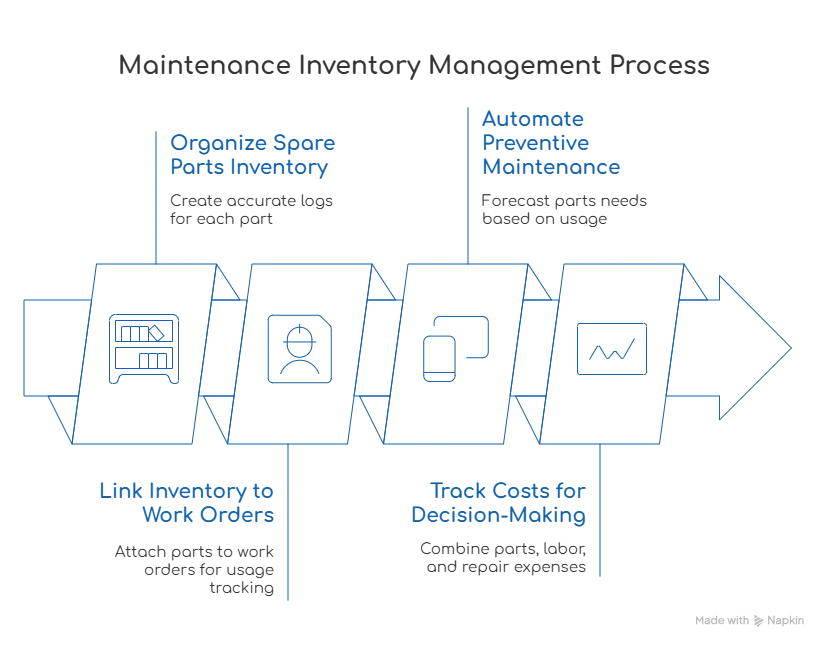Key Takeaways
- Centralize Spare Parts Tracking: Keep all parts organized with real-time logs to prevent stockouts and overstocking.
- Link Inventory to Work Orders: Automatically track parts used in repairs to maintain accurate stock levels.
- Automate Preventive Maintenance: Forecast part needs based on mileage or time to reduce downtime.
- Monitor Costs Continuously: Track parts, labor, and repairs together to identify cost-saving opportunities.
- Use Smart Tools Like Simply Fleet: Replace spreadsheets with a cloud-based system for visibility, control, and efficiency.
Maintenance inventory management is the process of tracking, storing, and managing all spare parts and consumables used in maintaining vehicles or equipment. It’s a key part of MRO (Maintenance, Repair, and Operations) management that ensures every repair or service has the right part at the right time.
For fleets, poor inventory control can quickly spiral into chaos like vehicles sitting idle waiting for parts, emergency purchases drive up repair bills, and teams waste hours searching for misplaced stock. By mastering maintenance inventory management, fleets gain operational efficiency, cost visibility, and maximum uptime.
What are the Common Challenges in Maintenance Inventory
Even well-organized fleets struggle with these common pitfalls:
Overstocking vs. Stockouts
Keeping too many parts ties up capital and storage space, while too few lead to downtime when critical components aren’t available.
Misplaced or Untracked Parts
Without a centralized tracking system, spare parts often “disappear,” especially when multiple technicians pull from the same stockroom.
Lack of Cost Visibility
When parts costs aren’t linked to specific vehicles or jobs, managers can’t see which assets drain the most money or which repairs are most expensive.
Reactive Instead of Preventive Ordering
Buying parts only when a failure occurs leads to rush orders, inflated prices, and unnecessary downtime.
Steps to Master Maintenance Inventory Management

Step 1 – Organize and Track Spare Parts Inventory
The first step in mastering maintenance inventory management is to organize your parts and create accurate logs. Each item (oil filter, brake pad, alternator) should have a part number, vendor, quantity on hand, and storage location.
Simply Fleet’s makes this process simple. It allows fleet managers to:
- Add and categorize spare parts by type, supplier, or vehicle.
- Track quantities in real-time and get low-stock alerts.
- Access digital records from any device—no more manual spreadsheets.
Example: A maintenance manager can open Simply Fleet’s dashboard and instantly see all filters, belts, or tires in stock, along with their cost and usage history.
This level of organization eliminates confusion, ensures accountability, and saves hours that would otherwise be lost searching for missing items.
Step 2 – Link Inventory to Work Orders
Inventory management must connect directly to work orders. Every repair or maintenance task consumes parts, so tracking usage at that level gives a full picture of maintenance costs.
In Simply Fleet, technicians can easily attach parts to a work order as they perform maintenance. The system automatically deducts those items from inventory, updating stock levels in real time.
This automation helps you:
- Understand which vehicles consume which parts most often.
- Prevent unrecorded parts usage.
- Streamline reordering with accurate consumption data.
Step 3 – Automate Preventive Maintenance with Inventory Forecasting
Predicting when parts will be needed is key to reducing downtime and avoiding emergency purchases. Preventive maintenance planning ensures parts are ready before a failure occurs.
Simply Fleet lets you automate maintenance scheduling based on mileage, time, or usage. As vehicles hit certain thresholds (say every 5,000 miles for an oil filter change) the platform can forecast which parts will be needed and alert you in advance.
Step 4 – Track Costs for Better Decision-Making
Spare parts are just one piece of the maintenance cost puzzle. True cost control happens when you combine parts, labor, and repair expenses into a single dashboard.
With Simply Fleet’s maintenance cost tracking and reporting tools, you can:
- See total spend per vehicle, part, or service category.
- Identify cost trends and high-expense areas.
- Compare preventive vs. corrective maintenance costs.
Best Practices for Cost-Effective Maintenance Inventory Management
Here are tried-and-true practices every fleet should follow:
- Standardize Parts Naming and Numbering: Ensure every part has a consistent name and SKU to prevent duplicates.
- Set Reorder Points: Use reorder alerts to avoid running out of essential items. Simply Fleet’s automated thresholds notify you when inventory hits minimum levels.
- Conduct Regular Cycle Counts: Schedule partial audits weekly or monthly to ensure system accuracy and reduce discrepancies.
- Go Digital: Cloud-based systems like Simply Fleet replace outdated spreadsheets, ensuring real-time access for all team members and preventing data loss.
- Review Reports Monthly: Use analytics to spot trends in consumption, costs, and downtime, adjusting stock levels accordingly.
Download Your Free Fleet Maintenance Resources Now!
Key Takeaways
Mastering maintenance inventory management means balancing availability with cost. Organized parts tracking, preventive maintenance, and real-time cost monitoring create a smoother, more predictable workflow.
Fleet managers who adopt tools gain:
- Lower downtime through proactive part readiness.
- Real-time insight into spending and consumption.
- Data-driven decisions that extend asset life and reduce waste.
Book a free demo with Simply Fleet to see how our platform helps you track parts, link work orders, and cut maintenance costs with complete visibility and control.



.png)








.png)


.png)



%20(1).webp)

.webp)



